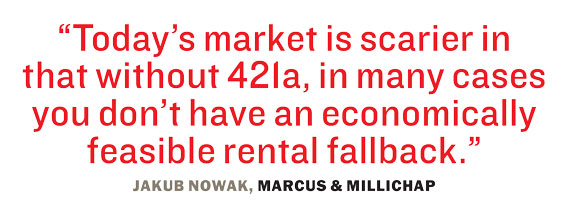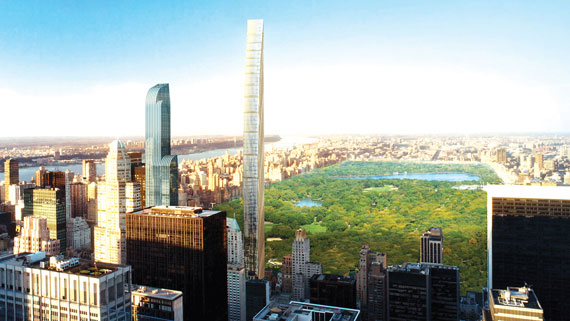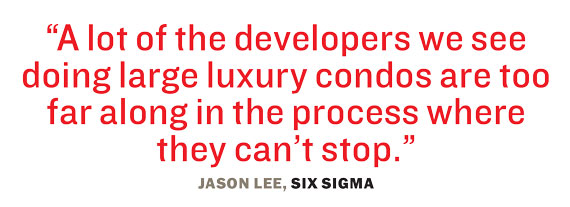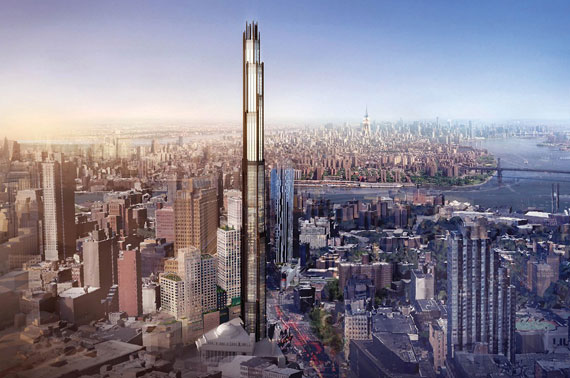Trending
Racing against the recession
With the clock ticking and the economy sending mixed signals, New York City developers change plans to try to outsmart the market

At the beginning of 2013, Joseph Chetrit and David Bistricer set the city’s real estate circles abuzz when they outbid 21 competitors to buy the Sony Building on Madison Avenue for an astonishing $1.1 billion. The team planned to convert the massive 850,000-square-foot office tower into luxury condos, a hotel and retail space. The cherry on top of the 37-story building, it was later revealed, would be a record-shattering $150 million penthouse.
“It’s 2007 all over again,” Dan Fasulo, the former head of research at Real Capital Analytics, told the New York Times at the time, adding, “It’s a real trophy in a great location, but that’s a big number for a transitional asset.”
Turns out the price tag may have indeed been too big. This past April, amid ever-heightening concerns about the state of the luxury condo market, the duo pulled the plug on the project, electing to sell the building for $1.4 billion to a partnership led by the Olayan Group. The Saudi family-run company is planning to maintain the Sony tower as an office building.
In a phone interview last month, Bistricer told The Real Deal that it was “a lot easier to transact” than to move forward with a condo conversion. But he added that there would “always be a market” for high-end luxury in the city.
Market watchers, of course, took a more skeptical view.
“They came to a fork in the road while the economy’s still good and decided to take the exit while it’s still profitable,” said Nancy Packes, a marketing consultant for high-end residential projects. “Not that many people have that kind of Plan B.”
Chetrit and Bistricer had plenty of reason to be wary of the economic future. The hard reality is that the U.S. economy has never gone through a period of expansion that’s lasted for more than 10 years (in fact, the norm is less than eight). The market is now seven years into its recovery, meaning the clock is likely ticking for New York City real estate players and the best outcome before 2020 may be prolonged uncertainty.
“Unless this cycle diverges from historic patterns, they’re going to be holding onto their assets at a period in the economic cycle that looks quite different from where we are now,” said economist Sam Chandan, dean of New York University’s Schack Institute of Real Estate.
Rick Jones, head of the finance and real estate groups at the law firm Dechert, offered a similar perspective. “We’re deep into a grinding expansion,” he said. “By normal standards, it’s at its end. We’re one black swan away from really seeing a recession occur.”
Chetrit and Bistricer are not the only developers rethinking their plans.
In January, Steve Witkoff shelved a conversion of the Park Lane Hotel — which sits on what is arguably one of the most coveted pieces of real estate on Central Park South — into a $2.3 billion condo tower. And in March, Michael Stern’s JDS Development Group and Kevin Maloney’s Property Markets Group announced plans to hold off on sales for a year at their Billionaires’ Row tower at 111 West 57th Street.
But it’s not just the luxury condo market that has industry players concerned.
New York’s investment sales market has been in correction mode for about a year, with overall sales activity in Manhattan dropping by 22 percent to $22.7 billion in the first half of the year. Hotel revenues and retail rents are falling as well, and as office rents approach their pre-recession peaks, observers are starting to wonder how much runway is left before that segment starts to turn.
 Concerns also persist over everything from the global economy to the upcoming presidential election to falling Wall Street bonuses. But determining exactly where we are in the cycle is far from a science. Further complicating matters this time around are contradictory economic indicators — U.S. employment and wage growth have steadily risen, but corporate profits, another sign of economic health, are down.
Concerns also persist over everything from the global economy to the upcoming presidential election to falling Wall Street bonuses. But determining exactly where we are in the cycle is far from a science. Further complicating matters this time around are contradictory economic indicators — U.S. employment and wage growth have steadily risen, but corporate profits, another sign of economic health, are down.
There’s also a consensus among economists that the length of an expansion does not necessarily mean that the risk of a recession is higher. Studies have shown that recent periods of economic growth have been getting progressively longer. As Fed Chair Janet Yellen noted in a February study, “Expansions don’t die of old age.”
Jones put it this way: “Sometimes you get an outlier. And sometimes the right genius ends up on the cover of Forbes.”
The city’s real estate market has also thus far proved uncommonly resilient: It has survived drops in oil prices and a slowing Chinese economy. Meanwhile, global uncertainty over historical events like Brexit might make New York an even more attractive haven for foreign capital.
With all the mixed signals, it’s not surprising to see NYC real estate players taking diverging strategies. Indeed, some developers are aggressively continuing construction and buying up land with little fear; others are freezing their projects in place, patiently waiting out the economic headwinds or selling their development sites entirely. Several — most notably Extell Development’s Gary Barnett — are even tapping a combination of those approaches for different projects and sites in their portfolios.
Writing on the wall?
At this time last year, the market appeared to be firing on all cylinders. But under the surface, a more ominous reality was developing. Analysts say certain market segments have been cooling for some time, and the broader industry is only starting to take note now.
“Really, it’s just in the last six months that the market’s acknowledged it,” said Jonathan Miller, the president of the appraisal firm Miller Samuel.
He added: “It’s as if each community was in its own silo.”
While pricing for closed units is still up, Miller said, those numbers are misleading because they represent contracts signed around late 2014 and early 2015. Prices for in-contract new development units peaked in late 2014 at $2.7 million.
And although certain sectors of the market are holding up strong — the $1 million-to-$3 million market in particular — Miller said he expects prices on closed deals to drop once units that were purchased after the market began slowing start closing.
Pricing aside, there are other vexing concerns in the new development market. Anxious to get projects built as prices were escalating, developers have filled the market with too much inventory. In Manhattan alone, there are currently some 14,000 new development units in the pipeline, according to Miller. At the current absorption rate, that works out to about five years of excess inventory.

Bob Knakal
“Everyone was sort of late,” he said. “Well, if you’re late to see this, how reliable are you going to be at predicting when the next market begins? They say ‘past performance doesn’t guarantee future returns,’ but I think it’s just the opposite. Past performance does show a pattern, and the pattern is a lack of understanding.”
That understanding is starting to set in, however. In a telling sign, trades of developable land are sinking. In fact, they dropped a startling 54 percent in the first half of the year, to $1.98 billion, compared to the same period last year. Those deals are important because they provide the financial underpinning for the high-stakes new development market and act as a barometer for what developers think the market will look like a few years into the future.
Despite that, pricing for development sites continues to rise. The price per buildable square foot for Manhattan development sites jumped 11 percent from last year, to roughly $700.
The disparity between sales and price is a classic sign of a market in transition, according to experts. Buyers are pulling back and sitting on the sidelines, so fewer deals are getting done. But those owners who are selling are finding buyers still willing to pay lofty prices.
“I believe we’re 10 months into a correction in the market,” said Bob Knakal, head of Cushman’s investment sales group. “People don’t always get it right away.”
Fewer Plan Bs
One thing that is clear is that today’s environment is different than the 2008 recession.
Following the last recession, a number of condo developers — Shaya Boymelgreen at 343 Fourth Avenue in Park Slope and RAL Companies at One Brooklyn Bridge Park, to name a few — changed construction plans mid-stream with an emphasis on building rentals.
But this time around developers have fewer Plan Bs available.
“Many condo projects that were going live at the time went rental or became rental-condo mixtures,” said Jakub Nowak, a broker with Marcus & Millichap who specializes in development sites in Brooklyn and Queens. “Today’s market is scarier in that without the 421a tax abatement, in many cases you don’t have an economically feasible rental fallback.”
Moreover, condo developers have been building much larger units than they did in the past, making it harder to convert those apartments into rentals.
Of the rental developers who were planning to tap 421a, which expired in January, some are stalling their projects in the program’s absence. The Durst Organization, for example, broke ground in January on the first, 400-unit phase of its $1.5 billion, 2,000-unit mega-project at Hallets Point in Astoria, but the following month the developer said it would put the rest of the project on hold because of the lack of 421a.
Not surprisingly, the landscape has made many condo developers wary of investing in New York. In the wake of the last recession, Time Equities CEO Francis Greenburger decided to halt construction at 50 West Street. He eventually resumed building, and the 189-unit luxury condo now has a projected sellout of $1 billion and is 60 percent sold. But he told TRD last month that he would be “very reluctant” to build a new condo in the city now. Like many developers, he has sought opportunities elsewhere, including in Canada and the Midwest.

111 West 57th Street
“A banker that I do business with put it well. He said, ‘This is the 10th inning in a nine-inning game,’” Greenburger said. “My philosophy is to vacay when the sun shines but carry a large umbrella. In an environment that exists today, we’re doing a lot of transactions, but we’re being very careful.”
Hitting the brakes
For those who think the market is, in fact, living on borrowed time, it may seem like a no-brainer to pack up and go home — or at least come up with a plan other than construction.
When the market tanked back in 2008, after all, developers faced a perfect storm of financial horror: Buyers began bailing on contracts, lending froze up, tourism tanked, unemployment spiked, and the list goes on.
Starting construction is simply more risk than many developers can take.
“It’s like staying inside a burning building and hoping the fire goes out,” said Teo Nicolais, a real estate entrepreneur who teaches at Harvard. “Once you pull the trigger, you better finish the project.”
Kuafu Properties, for one, seems to be heeding the warning. The firm — which is backed by Chinese capital and led by entrepreneur and former Queens lawyer Shang Dai — quickly became one of the city’s most active buyers of big development sites when it burst onto the scene in 2013. In just about 18 months, it ponied up $750 million on acquisitions including a 320,000-square-foot hotel development site on the Far West Side known as Hudson Rise (which it paid $115 million for) and an Upper East Side development site at 86th Street and Lexington Avenue where the company plans to build a 223,000-square-foot retail-and-condo property (which went for $134 million). Its most expensive buy came in 2015, when the firm paid $300 million for an assemblage with more than 300,000 buildable feet on East 60th Street across from Bloomingdale’s. The site can potentially house a condo building up to 1,240 feet, in the vein of a Billionaires’ Row tower.
But in a sign of possible market bearishness, Kuafu said it was planning to hold off on the project for now. “We acquired that asset with the next cycle in mind already when we saw that, right away,” Stephen Muller, the company’s chief investment officer, said during an episode of “The Stoler Report” in April. “And so, we levered accordingly.”
More specifically, sources said, Kuafu was wary of a glut of high-end condos around Billionaires’ Row and decided it would be better to wait until some of the excess supply burns off.
But even for those who decide to build, finding construction lending is another tricky challenge these days. And should the Federal Reserve start raising interest rates, debt service on properties will become more expensive, making it harder to hold onto a site or manage a stalled project with ever-greater carrying costs.
“There’s an old saying in residential development,” said Glenn Mueller, a professor of real estate and construction management at the University of Denver. “Carry kills.”

Matthew Galligan
The difficulty of securing financing has already caused problems for some.
Developer Ian Bruce Eichner reportedly couldn’t find financing for a development site he bought in 2013 in East Harlem, which he is now being forced to sell to his lender, the Durst Organization. And NYC newcomer Joseph Beninati is facing foreclosure after failing to land construction financing for his condo project dubbed 3 Sutton Place.
Others may just be sitting tight.
Over in West Chelsea, where luxury condos designed by starchitects surround the High Line, Maloney’s PMG bought a four-story warehouse for $39.9 million in the summer of 2014, when new development sales prices were peaking. The following January, the firm filed plans to add 17 stories and convert it to a 21-unit luxury condo. But in June, PMG, which has its hands full as the co-developer of 111 West 57th and a trio of large sites in Long Island City, announced that it had leased the 38,000-square-foot building, which sits at 548 West 22nd Street, to the gallery Hauser & Wirth for two years. That gives PMG $3.8 million in annual revenue.
Officials from PMG declined to comment, but some have speculated that the developer inked the deal to keep the property stable while it waits for the market to improve. “It’s smart [to hold back] if you’re in that position,” said Six Sigma NYC President Jason Lee, who’s developing a condo at 517 West 29th Street. “A lot of the developers we see doing large luxury condos are too far along in the process where they can’t stop.”
Meanwhile, in February, developer Simon Baron bought a site in Greenpoint for $24 million that could be developed into a roughly 133,000-square-foot office-and-retail building. A source close to the deal said that the firm liked that the building had retail tenants in place, because it takes the pressure off having to build immediately.
And at the Park Lane, Witkoff, of course, has the option of continuing to operate the property as a hotel. The developer has, though, sent mixed signals about whether he’s really sitting on the condo conversion or moving forward.
“The fact of the matter is, the velocity is not what it was,” he said in an interview with Bloomberg News in January, referring to a slowdown in the ultra-luxury condo market. “Because we have a cash flow, we have the flexibility to wait.”
In April, however, when former Park Lane investor Al Waseet International sold a 41 percent stake in the building to China’s Greenland Group, the new partner released a statement saying the property will be developed and have a sellout price of $3.6 billion to $4.3 billion.
Then there are those who are opting to sell.
In addition to Chetrit and Bistricer at Sony, Barnett has recently sold off a number of sites. Late last year, he unloaded a $265 million portion of the Riverside Center, a mega-project he owned with the Carlyle Group, and in August he sold a West 58th Street site slated for a 41-unit residential building.
Extell is currently shopping a 135,000-square-foot site in NoMad that sources speculate could sell for north of $74 million.
Doubling down
Whether it’s some kind of oracle-like market intuition, pure hubris or some combination of both, there will always be aggressive developers who double down on the market.
 During the last cycle, some developers fared the storm well, making a compelling case for forging ahead.
During the last cycle, some developers fared the storm well, making a compelling case for forging ahead.
In what is now part of the annals of NYC real estate, Barnett was constructing One57 in 2009, when there was nary a crane elsewhere on the city’s skyline. When the tower officially launched sales in late 2011, it was the only new luxury development on the market. Amid the influx of foreign buyers, units sold briskly for about two years until competing towers like Harry Macklowe and CIM Group’s 432 Park Avenue and Vornado Realty Trust’s 220 Central Park South finally appeared.
Similarly, Forest City Ratner completed its Frank Gehry-designed 8 Spruce Street in 2012 at a time when few, if any, developers were building.
The $850 million project, which started construction in April 2008, hit the pause button in 2009 and modified its loans, but because Forest City was able to power through the recession, the 900-unit rental tower benefited from being the only new product on the market when it started leasing in 2011.
“The smart developers build if they can get financing when things are really bad in anticipation of being sales-ready as the economy returns, when there’s little competition,” said Cushman & Wakefield investment sales broker Mark Weiss. “It’s a timing play as much as anything else.”
While Barnett did sell off some sites, he appears to be moving forward with his 1,550-foot-tall follow-up to One57 on Billionaire’s Row: a 183-unit spire known as Central Park Tower that will house the city’s first Nordstrom at its base.
And in May, Robert Gladstone’s Madison Equities filed plans to build a 66-story, 150-unit condo tower Downtown at 45 Broad Street, which will rise 1,127 feet. Madison — along with its partner the Pizzarotti Group — bought the development site late last year for $86 million and has a projected sellout of about $624.4 million.
Meanwhile, the Moinian Group filed plans in July to develop a 40-unit condo building at 220 11th Avenue designed by the late architect Zaha Hadid. The developer plans to kick off construction in early 2017 and launch sales during the second half of the year.
Across the river in Downtown Brooklyn, where the market is thought to have a longer horizon, JDS is working with Chetrit to build a supertall tower at 340 Flatbush Avenue Extension. The 73-story tower, which would be the tallest building in the borough by far at 1,066 feet, is slated to house nearly 500 rentals.
And in Queens, plans for the borough’s first supertall tower seem to be chugging forward. In February, Flushing-based developer Chris Jiashu Xu filed plans to build a 79-story building at 23-15 44th Drive in Long Island City with 774 apartments.
Will the shoe drop?
Determining what to do as a developer often comes down to crunching the numbers, making predictions and then rolling the dice. While residential statistics are obviously a key predictor of the condo market, developers need to assess the market as a whole.

340 Flatbush Ave
And it seems investors are looking for safer plays, whether it be moving away from new construction into multifamily properties or switching capital from equity to less risky debt positions.
“Everybody’s reevaluating their risk profile and what they’re going to do,” said power lawyer Jay Neveloff of the firm Kramer Levin Naftalis & Frankel.
Even Barnett is diversifying into safer bets at some projects — though with so many projects in the air, he provides an example for almost every strategy out there. On the Lower East Side, he’s targeting Asian and local buyers with condos starting around $1 million at his One Manhattan Square.
And developer Ben Shaoul is going after the middle market of roughly $1 million to $5 million per unit at three of his four current condo projects.
Barnett, like others, is also selectively dropping prices.
In January, he cut more than $200 million off One Manhattan Square’s overall sellout, to $1.88 billion. And at Central Park Tower, he filed a condo plan with the state attorney general’s office this year but then withdrew it, suggesting that he might be considering cutting prices there.
Similarly, developers World Wide Group and Rose Associates have dropped the total sellout from $768.5 million to $704.96 million at their 65-story condo tower at 252 East 57th Street.
And Toll Brothers City Living started dropping prices in February at 1110 Park Avenue, a boutique, limestone-clad condo building with nine units. The total sellout is now down 16 percent from the original projection, to $147.78 million.
“You’ve got to adjust to the market,” said Toll Brothers City Living President David von Spreckelsen. “It is what it is.”
Indicators to watch
While many will disagree about how much gas is left in the economy’s tank, there’s no question about the factors that fuel the city’s real estate market.
“From a real estate perspective, there are two key drivers to success,” said Matthew Galligan, president of the real estate finance group at the commercial lender CIT. “One is low interest rates, and the other is employment growth.”
With the former, there are signs that the party might be coming to an end. In August, Yellen signaled a stronger case for raising rates after kicking the can in July following a weak jobs report and uncertainty over the impending Brexit vote.
However, New York City added 98,100 jobs in the 12 months ending in July, according to the New York State Department of Labor. That represented a year-over year gain of 2.3 percent, compared to the national growth rate of 1.7 percent. But a report from the brokerage Savills Studley late last month showed that while job growth was strong, it was primarily centered in sectors like education and health care that don’t typically take a lot of office space — a concern at a time when developers are adding millions of square feet of new office supply.
Yet, as a sign of investor confidence in the U.S. economy, the stock market has had a strong showing in recent months. The S&P 500 is up 19 percent since hitting a yearly low in February. For NYC real estate, it means that potential buyers are feeling richer these days.
Still, one can only read so far into the numbers, Galligan cautioned. They can be used as a basis, but when a real estate player comes to that fork in the road, each will have to make a decision based on a broader reading of the market. At the end of the day, he said, “You can’t see tomorrow.”




